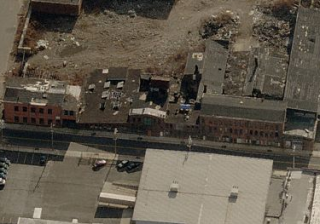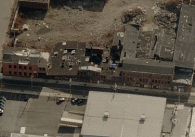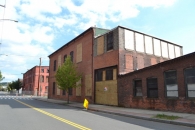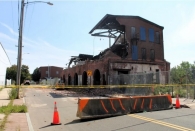Mill Record New Haven
RETURN TO ‘FIND MILLS’Disclaimer: Content for these properties was compiled in 2014-2017 from a variety of sources and is subject to change. Updates are occasionally made under Property Information, however the Connecticut Trust for Historic Preservation (dba Preservation Connecticut) makes no representation or warranty that the information is complete or up-to-date.
- Complex Name (Common)
- Bigelow Co. ALL DEMO’D EXCEPT EASTERN 1884 BLOCK 9/2023
- Complex Name (Historic)
-
- Bigelow Co.
- Address or Location
- 190-198 River Street, Fair Haven, New Haven
- County
- New Haven
- Historic Designation
- Associated Mill Community
- n/a
 What can you do at this mill?
What can you do at this mill?
- Historic Information
Companies Associated w/Complex
- Bigelow Co. 1883-1963
- Etherington Co. 1975-1980s
- H. B. Bigelow & Co. 1881-1883
- Malleable Iron Fittings Co. 1963-1964
- MIF Industries, Inc. 1964-1969
- Waltham Industries 1969-1975
Use (Historic)
Largest Documented Workforce
150 (1890s).
Historic Narrative
The Bigelow Company was incorporated in New Haven, Connecticut by Hobart B. Bigelow, a native of North Haven, in 1883. Born in 1834, Bigelow had extensive experience in industry having apprenticed as a machinist at the Guilford Manufacturing Company of Guilford, Connecticut, and the New Haven Manufacturing Company, in New Haven. Upon the completion of his training, Bigelow went on to find employment as foreman of the machine department at the firm of Ives and Smith, which later became Wilcox and Gay. Around 1860, Bigelow secured controlling interest in Wilcox and Gay, and shortly thereafter acquired the foundry operated by Cyprian Wilcox, one of the partners in Wilcox and Gay. These enterprises were then combined as the Bigelow Manufacturing Company, which operated on Whitney Street in New Haven until 1869 when larger quarters were required. Bigelow acquired a property in a developing industrial area west of the Mill River on what was known at the time as ‘Grapevine Point’ in 1869. A former Civil War-era barracks was occupied unitl a dedicated plant could be built for the firm, this starting in 1873 after a fire destroyed the original plant. Much of the Bigelow Company’s early work was dedicated to the manufacture of steam engines and sugar mills, however, around 1868 the firm added a department specializing in the production of steam boilers, which would soon become the company’s specialty. In 1875, Bigelow brought on a partner, Henry Elson, and the business was reorganized as H.B. Bigelow and Company. In 1877, another partner, George S. Barnum, was brought into the business, thus marking the entry of a family that would remain associated with the firm for the rest of its history. H.B. Bigelow and Company was incorporated as the Bigelow Company in 1883, three years after Hobart Bigelow helped organize the National Pipe Bending Company, a firm dedicated to the manufacture of boiler components. Both companies enjoyed considerable success through the remainder of the 19th century and the Bigelow Company in particular gained an extensive market share based on its ability to produce high quality boiler plants in a variety of sizes for applications ranging from public buildings to industrial plants. Horace Bigelow also enjoyed a degree of success in the political sphere, serving in the State Legislature from 1875 to 1877, as mayor of New Haven from 1879 to 1881, and as governor of Connecticut from 1881 to 1883. The Bigelow Company remained a prominent fixture in the State’s industrial landscape into the middle of the 20th century. In 1963, the business was acquired by the Malleable Iron Fittings Company (MIF), a Branford, Connecticut-based manufacturer of steam fittings incorporated in 1864, which embarked on a program to modernize both the MIF and Bigelow Company plants. The firm expanded further a year later after merging with the Detroit, Illinois-based Detroit Brass and Malleable Company, thus forming MIF Industries, Inc. This venture did not achieve the successes that had been hoped for and limped on until 1969 when it was acquired by Waltham Industries, a Delaware-based investment firm. The Bigelow Company was eventually closed during the 1980s.
- Architectural Information
Number of Existing Buildings
AS OF 9/2021 only the 1881 3-story block remains. Seven (7) adjoining primary blocks.
Dates of Construction
1881, 1884, 1889, 1902, ca. 1920.
Architect
n/a
Builder
n/a
Building Type
Architectural Description
As of 9/2023 only the 1881 3-story brick block toward the western end of the site remains. The former Bigelow Company plant is comprised of roughly seven primary adjoining blocks located on the south side of River Street, at the southeast corner of River Street’s intersection with Lloyd Street. The three oldest buildings associated with the property were erected in 1881 and 1884. The most notable of the three is a three-story, 102’ x 42’ red brick block located near the western end of the facility. This was erected in 1881 as a plate iron and machine shop and has segmental-arched window openings with stone sills, a denticulated and corbelled red brick cornice with shallow returns, and a low-pitch side-gabled roof. Five large round-arched openings with brick surrounds are evenly spaced across the façade. These originally allowed for large equipment to move in and out of the building but were later partially enclosed as windows. They currently have stone sills and paired double-hung windows with and paired, quarter-round, multi-pane windows above. The main boiler shop formerly extended from the rear of this block, however, this was recently removed due to an extensive degree of deterioration. The first of two blocks built in 1884 adjoins the east elevation of the plate iron and machine shop and was originally used as a pattern shop and office building. It is a two-story, 40’ x 42’ red brick building with a mix of segmental-arched and rectangular window openings, stone sills and lintels, a denticulated and corbelled red brick cornice, and a flat roof. A large loading door with a stone sill and wood hoist beam is centered on the second story of the block, however, it is unclear whether this is an original feature or was added at a later date. A similar alteration is found on the façade of the second 1884 block, which adjoins the east elevation of the pattern shop. This originally served as an office building and is a two-story, 46’ x 40’ red brick block with segmental-arched window openings, stone window sills, a denticulated and corbelled red brick cornice, and a low-pitch front-facing gable roof. A variety of door and window openings are asymmetrically placed across the façade, several of them showing signs of being enlarged or otherwise altered. A 56’ x 101’ block or red brick construction adjoins the east elevation of the original office building. This has a shed roof that is pitched to the east and drops from one-and-a-half-stories in height on its western side to nearly three-quarters of a story to the east. The building was erected in 1889 to house a machine shop and has a single loading door and several sizes of segmental-arched window openings with stone sills spanning the façade. The cornice has red brick dentils. A one-and-a-half-story, 18’ x 46’ red brick block was built adjoining the east elevation of the machine shop in 1902. This was raised to two-stories via a concrete block addition ca. 1920. The block was likely used for shipping and storage as it has a large loading door facing the street. The original portion has segmental-arched window openings, however, these have been infilled with brick. The addition has rectangular window openings with concrete sills and multi-pane metal sash. The eastern end of the plant is anchored by a two-story, 70’ x 48’ red brick block built in 1902. This supplanted the earlier office building yet also housed a carpentry shop on its first floor. The block has segmental-arched window openings with concrete sills (some reduced to create rectangular openings), a denticulated and corbelled red brick cornice that wraps around all but the west sides of the building, and a low-pitch side-gabled roof. All of the windows retain the iron hardware that formerly supported protective shutters. A painted sign that reads, ‘THE BIGELOW CO.’ is located on the block’s north elevation, and a loading bay with a modern roll-up door can be found on the east elevation.
Exterior Material(s)
Structural System(s)
Roof Form
Roof Material
Power Source
Condition
Fair, Deteriorated
Condition Notes
The complex is in fair to deteriorated condition. Many of the exterior walls are in need of repairs and a number of the original windows throughout the complex have been infilled or are damaged. Several blocks formerly located at the rear of the plant have been recently demolished.
- Property Information
-
Specific Location
One legal parcel (198 River Street) totaling 4.11 acres located on the south side of River Street, at the southwest corner of River Street’s intersection with Lloyd Street.
Located in the River Street Historic District.Adjacent To
n/a
Exterior Visible from Public Road?
Yes
Parcel ID / Assessor Record Link
- 175/0608/00200. / Link →
Acreage
4.11
Use (Present)
- Commercial
- Other: DECD awarded $646,500 in brownfields grant 6/2021 for remediation/cleanup of portion of building for commercial/light industrial redev. The City of New Haven demo'd all but the 3-story 1881 brick block and easternmost 2-story 1884 brick block 9/2021. 4/2022 The building at 190 River Street has been adapted as a brewery. The 1881 block came down 9/2023.
- Sources
-
Form Completed By
Lucas A. Karmazinas
Date
10/08/2015
Bibliography
- List of Connecticut Manufacturers, 1922, 1924, 1930, 1932.
- Directory of Connecticut State Manufacturers, 1936, 1939.
- Industrial Directory of Connecticut, 1947.
- Register of War Production Facilities in Connecticut, 1951.
- Map of New Haven County; Clark, Richard, 1859.
- Atlas of New Haven County, Beers, Ellis & Soule, 1868.
- Aerial Survey of Connecticut, 1934, 1965.
- Sanborn Map Company, 1901, 1911, 1923, 1950.
- New Haven City Directory; Various editions.
- History of the City of New Haven to the Present Time, 1887.
- Illustrated Popular Biography of Connecticut; Case, Lockwood & Brainard Co., 1891.
- A Modern History of New Haven and Eastern New Haven County, 1920.
- Hartford Courant, 1930, 1963.
- Roth, Matthew, et al, Connecticut: An Inventory of Historic Engineering and Industrial Sites (Washington DC: SIA, 1981).
- Roth, Matthew and Bruce Clouette. 1988. River Street Historic District National Register Nomination No. 88003213.
- National Park Service.
- Representative View(s)Click on image to view full file








